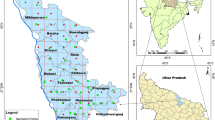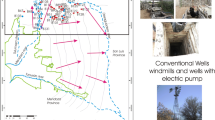Abstract
About one-third of the earth’s land surface is facing challenge of water scarcity in both quantitative and qualitative terms (Postel SL, Last oasis: facing water scarcity, 2nd edn. W.W. Norton, New York, 1997). In the last few decades, the global finding of the presence of elevated concentrations of various toxic solutes from natural and anthropogenic sources has limited the available volume of safe drinking water. Understanding the aquifer hydraulic properties and hydrochemical characteristics of water is crucial for proper planning, management and sustainable utilization of groundwater. Generally, the motion of groundwater along its flow paths below the ground surface increases the concentration of the chemical species; hence the groundwater chemistry could reveal important information on the geological history of the aquifers and the suitability of groundwater for domestic, industrial and agricultural purposes (Kortatsi BK, Aquat Geochem 13(1):41–74, 2007).
Access this chapter
Tax calculation will be finalised at checkout
Purchases are for personal use only
Similar content being viewed by others
References
APHA (American Public Health Association) (2005) Standard methods for the examination of water and wastewater, 21st edn. American Public Health Association, American Water Works Association, and Water Environment Federation, Washington, DC
Bhattacharya P, Chatterjee D, Jacks G (1997) Occurrence of arsenic contamination of groundwater in alluvial aquifers from Delta Plain, Eastern India: option for safe drinking supply. Int J Water Resour Dev 13:79–92
Bhattacharya P, Claesson M, Bundschuh J, Sracek O, Fagerberg J, Jacks G, Martin RA, Storniolo AR, Thir JM (2006) Distribution and mobility of arsenic in the Río Dulce Alluvial aquifers in Santiago del Estero Province. Argent Sci Total Environ 358(1–3):97–120
Bhattacharya P, Mukherjee AB, Bundschuh J, Zevenhoven R, Loeppert RH (2007) Arsenic in soil and groundwater environment: biogeochemical interactions, health effects and remediation. In: Nriagu JO (ed) Trace metals and other contaminants in the environment. Elsevier, Amsterdam
Bhattacharya P, Mukherjee A, Mukherjee AB (2011) Arsenic contaminated groundwater of India. In: Nriagu J (ed) Encyclopedia of environmental health. Elsevier, Amsterdam
BIS (1991) Specifications for drinking water, IS:10500:1991. Bureau of Indian Standards, New Delhi, India
Chauhan VS, Nickson RT, Chauhan D, Iyengar L, Sankararamakrishnan N (2009) Ground water geochemistry of Ballia district, Uttar Pradesh, India and mechanism of arsenic release. Chemosphere 75:83–91
Galy A, France-Lanord C (1999) Weathering processes in the Ganges-Brahmaputra basin and the riverine alkalinity budget. Chem Geol 159:31–60
Garrels RM (1967) Genesis of some ground waters from igneous rocks. In: Abelson PH (ed) Researches in geochemistry. Wiley, New York
Grout H (1995) Characterisation physique, mineralogique, chimique et signification de la charge particulaire et colloýdale derivieres de la zone subtropicale. Unpublished PhD thesis, Aix-Marseille, France
Kortatsi BK (2007) Hydrochemical framework of groundwater in the Ankobra Basin, Ghana. Aquat Geochem 13(1):41–74
Kumar P, Kumar M, Ramanathan AL, Tsujimura M (2010) Tracing the factors responsible for arsenic enrichment in groundwater of the middle Gangetic Plain, India: a source identification perspective. Environ Geochem Health 32(2):129–146
Mukherjee A, Bhattacharya P, Savage K, Foster A, Bundschuh J (2008) Distribution of geogenic arsenic in hydrologic systems: controls and challenges. J Contam Hydrol 99:1–7
Muralidharan D (1998) Protection of deep aquifers from arsenic contamination in Bengal Basin. Curr Sci 75(4):351–353
Piper AM (1944) A graphic procedure in the geochemical interpretation of water analyses. AGU Trans 25:914–923
Postel SL (1997) Last oasis: facing water scarcity, 2nd edn. W.W. Norton, New York
Ravenscroft P, Burgess WG, Ahmed KM, Burren M, Perrin J (2005) Arsenic in groundwater of the Bengal basin, Bangladesh: distribution, field relations, and hydrological setting. Hydrogeol J 13:727–751
Rowland HAL, Gault AG, Lythgoe P, Polya DA (2008) Geochemistry of aquifer sediments and arsenic-rich groundwaters from Kandal Province. Cambodia Appl Geochem 23:3029–3046
Smedley PL, Kinniburgh DG, Macdonald DMJ, Nicolli HB, Barros AJ, Tullio JO, Pearce JM, Alonso MS (2005) Arsenic associations in sediments from the loess aquifer of La Pampa. Argent Appl Geochem 20:989–1016
Verma SS (2009) Geo-hydrological study of Gorakhpur city. Sectoral study conducted by Department of geography, D.D.U. Gorakhpur University, Gorakhpur
Welch AH, Westjohn DB, Helsel DR, Wanty R (2000) Arsenic in ground water of the United States: occurrence and geochemistry. Ground Water 38:589–604
WHO (1993) Guidelines for drinking water quality, vol 1, 2nd edn, Recommendations. World Health Organization, Geneva, p 188
WHO (2011) Guidelines for drinking water quality: recommendation edn, vol 4. World Health Organization, Geneva
Author information
Authors and Affiliations
Corresponding author
Editor information
Editors and Affiliations
Rights and permissions
Copyright information
© 2015 Capital Publishing Company
About this chapter
Cite this chapter
Kumar, H., Ranjan, R.K., Yadav, S., Kumar, A., Ramanathan, A. (2015). Hydrogeochemistry and Arsenic Distribution in the Gorakhpur District in the Middle Gangetic Plain, India. In: Ramanathan, A., Johnston, S., Mukherjee, A., Nath, B. (eds) Safe and Sustainable Use of Arsenic-Contaminated Aquifers in the Gangetic Plain. Springer, Cham. https://doi.org/10.1007/978-3-319-16124-2_7
Download citation
DOI: https://doi.org/10.1007/978-3-319-16124-2_7
Publisher Name: Springer, Cham
Print ISBN: 978-3-319-16123-5
Online ISBN: 978-3-319-16124-2
eBook Packages: Earth and Environmental ScienceEarth and Environmental Science (R0)




